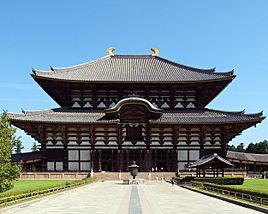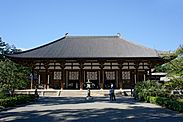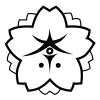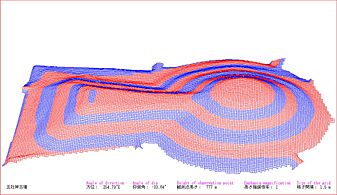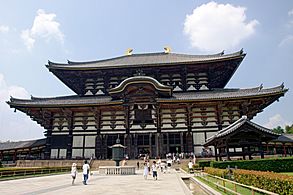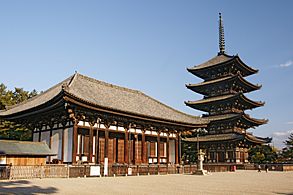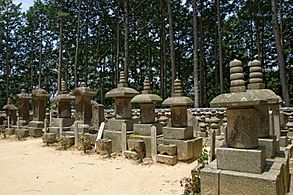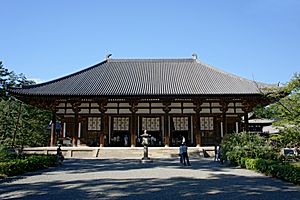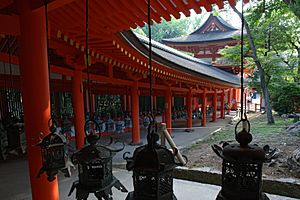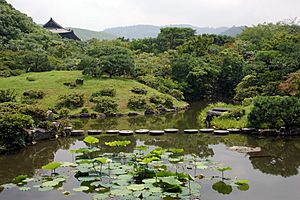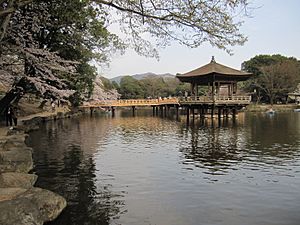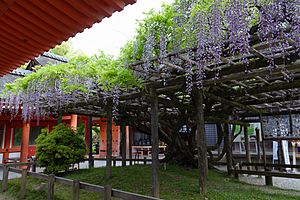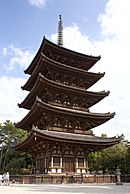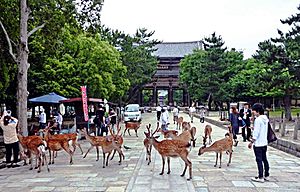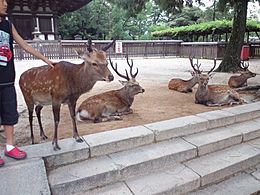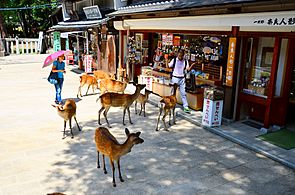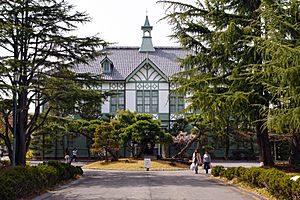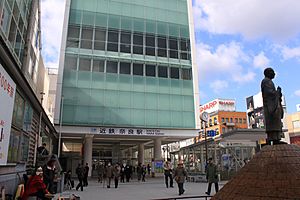Nara (city) facts for kids
Quick facts for kids
Nara
奈良市
|
|||||||||||||
|---|---|---|---|---|---|---|---|---|---|---|---|---|---|
| Nara City | |||||||||||||
|
From top left: Todai-ji, Toshodai-ji, Yakushi-ji, the sika deer in Nara Park, the garden of the former Daijyo-in and Kasuga-Taisha
|
|||||||||||||
|
|||||||||||||
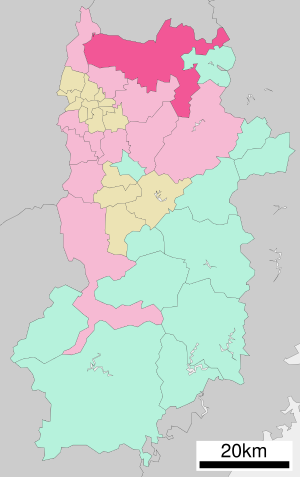 |
|||||||||||||
| Country | Japan | ||||||||||||
| Region | Kansai | ||||||||||||
| Prefecture | Nara Prefecture | ||||||||||||
| Area | |||||||||||||
| • Total | 276.84 km2 (106.89 sq mi) | ||||||||||||
| Population
(2022)
|
|||||||||||||
| • Total | 367,353 | ||||||||||||
| • Density | 1,326.951/km2 (3,436.79/sq mi) | ||||||||||||
| Time zone | UTC+09:00 (JST) | ||||||||||||
| City hall address | 1-1-1 Nijō-ōji, Nara-shi, Nara-ken 630-8580 |
||||||||||||
| Website | City of Nara | ||||||||||||
|
|||||||||||||
| UNESCO World Heritage Site | |
|---|---|
| UNESCO World Heritage Site | |
| Official name | Historic Monuments of Ancient Nara |
| Includes |
|
| Criteria | Cultural: (ii)(iii)(iv)(vi) |
| Inscription | 1998 (22nd Session) |
| Area | 617 ha (1,520 acres) |
| Buffer zone | 1,962.5 ha (4,849 acres) |
Nara (奈良市, Nara-shi, [naꜜɾa]) is the capital city of Nara Prefecture, Japan. It's a big city in the Kansai region of Honshu. As of 2022[update], Nara has about 367,353 people. This makes it the largest city in Nara Prefecture.
Nara was once the capital of Japan. This was during the Nara period, from 710 to 794. The Emperor lived here before the capital moved to Kyoto. Nara is famous for its eight temples, shrines, and old ruins. These include Tōdai-ji, Saidai-ji, Kōfuku-ji, Kasuga Shrine, Gangō-ji, Yakushi-ji, Tōshōdai-ji, and the Heijō Palace. These places, along with Kasugayama Primeval Forest, are known as the Historic Monuments of Ancient Nara. They are a UNESCO World Heritage Site.
Contents
What's in a Name? The Meaning of "Nara"
The name "Nara" has been written in many ways over time. People have used different Japanese characters for it. For example, some old writings used characters that mean "flat" or "peaceful."
There are a few ideas about where the name "Nara" came from. The most popular idea today comes from a famous folklorist named Kunio Yanagita.
"Flat Land" Theory
This idea says that "Nara" comes from a word meaning "flat land" or "gently sloping." In some parts of Japan, a gentle slope on a mountain is called naru. This word is related to narasu, which means "to flatten."
Many old documents support this idea. They show that the character for "flat" (平) was often used to write "Nara." This makes the "flat land" theory the most likely one.
Other Ideas for the Name
- Some think "Nara" comes from nara, the Japanese word for "oak tree." Oak trees were common in the area.
- Another idea is that "Nara" might be an old loanword from Old Korean. In Korean, nara means "country" or "kingdom."
- There's also a theory that it's linked to a Tungusic word na, meaning "earth" or "land."
Nara's Rich History
Early Nara and Its Beginnings
Nara has many ancient burial mounds called kofun. These are huge tombs built a long time ago.
In 708 AD, Empress Genmei decided to move the capital to Nara. The city was called Heijō or Heijō-kyō back then. It became Japan's first permanent capital in 710 CE. It was the center of government until 784 CE. After that, the capital moved to Nagaoka-kyō and then to Heian-kyō (Kyoto). Kyoto remained the capital for over 1,100 years.
The city of Nara (Heijō) was designed like the Chinese capital of Tang China, called Chang’an. It was laid out in a grid pattern. This design helped show the ruler's power. Nara also became a major center for Buddhism. Many temples were built, and some, like Yakushiji and Todaiji, are still standing today.
Religion and Famous Temples
When Nara became the capital, the important temple of Asuka-dera was moved here. Emperor Shōmu ordered the building of Tōdai-ji Temple. This temple has the world's largest wooden building and the world's largest bronze Buddha statue.
The temples of Nara are very important. They are known as the Nanto Shichi Daiji. Even after the capital moved to Kyoto in 794, these temples remained spiritually significant. This is why Nara is sometimes called Nanto, meaning "the southern capital."
In 724 AD, the government asked wealthy people to make their homes look grander. They wanted them to fix up roofs, pillars, and walls. This was to make the city look even more magnificent.
Visiting Nara became popular during the Edo period. Many maps for visitors were printed. Later, during the Meiji Period, some temples like Kofukuji lost land. This was because Buddhism was linked to the old government.
Modern Nara Today
Even though Nara was Japan's capital for a long time, it wasn't officially called a "city" until February 1, 1898. Since then, Nara has grown into a modern tourist city. People come from all over to see its many historical temples, landmarks, and national monuments.
In December 1998, Nara was added to the UNESCO World Heritage Sites list. Many shops, traditional inns (ryokans), and art galleries in Nara have kept their old Japanese style.
Nara hosts many traditional festivals every year. One is the Neri-Kuyo Eshiki, a spring festival at Todaiji temple that's over 1,000 years old. Another is the Kemari Festival, where people wear old costumes and play traditional games.
In 1909, Tatsuno Kingo designed the Nara Hotel. It mixed modern ideas with traditional Japanese architecture.
On July 8, 2022, former Prime Minister of Japan Shinzo Abe passed away in Nara.
Nara's Geography and Climate
Nara city is in the northern part of Nara Prefecture. It shares a border with Kyoto Prefecture to the north. The city is about 22.22 kilometers from north to south and east to west. Since 2005, Nara also borders Mie Prefecture to its east. The total area of the city is 276.84 square kilometres (106.89 square miles).
Nara city is located in the Nara Basin. This basin is a flat area where many important towns are found. It's the most crowded part of Nara Prefecture.
The main part of Nara city is east of the old Heijō Palace site. Many government offices are on a street called Nijō-ōji. Major banks are on Sanjō-ōji. Both of these streets run east to west.
The highest point in Nara is Kaigahira-yama, which is 822.0 m (2,696.85 ft) high. The lowest point is in Ikeda-cho district, at 56.4 m (185.04 ft) above sea level.
Nara's Weather
Nara Prefecture generally has a mild climate. However, the weather is different in the flat basin area compared to the mountains.
The basin area has an inland climate. This means there are bigger differences between day and night temperatures. There are also bigger differences between summer and winter. In winter, temperatures are usually around 3 to 5 °C (37 to 41 °F). In summer, they are from 25 to 28 °C (77 to 82 °F), sometimes reaching close to 35 °C (95 °F). It doesn't snow much in Nara city.
The mountainous areas have cooler temperatures. In winter, it can get as cold as −5 °C (23 °F). These areas also get a lot of rain in the summer. The yearly rainfall can be as much as 3,000 to 5,000 mm (118.11 to 196.85 in). This is one of the highest rainfall amounts in Japan.
Spring and fall are mild and pleasant. Many people visit the Yoshino mountains in spring to see the cherry blossoms. In autumn, the southern mountains are popular for their beautiful fall leaves.
| Climate data for Nara (1991–2020 normals, extremes 1953–present) | |||||||||||||
|---|---|---|---|---|---|---|---|---|---|---|---|---|---|
| Month | Jan | Feb | Mar | Apr | May | Jun | Jul | Aug | Sep | Oct | Nov | Dec | Year |
| Record high °C (°F) | 18.9 (66.0) |
23.9 (75.0) |
25.9 (78.6) |
30.5 (86.9) |
33.6 (92.5) |
36.5 (97.7) |
38.1 (100.6) |
39.3 (102.7) |
36.9 (98.4) |
32.0 (89.6) |
26.8 (80.2) |
24.9 (76.8) |
39.3 (102.7) |
| Mean daily maximum °C (°F) | 9.0 (48.2) |
10.0 (50.0) |
14.0 (57.2) |
20.0 (68.0) |
24.7 (76.5) |
27.4 (81.3) |
31.3 (88.3) |
33.0 (91.4) |
28.5 (83.3) |
22.6 (72.7) |
16.8 (62.2) |
11.4 (52.5) |
20.7 (69.3) |
| Daily mean °C (°F) | 4.2 (39.6) |
4.7 (40.5) |
8.0 (46.4) |
13.5 (56.3) |
18.5 (65.3) |
22.2 (72.0) |
26.2 (79.2) |
27.3 (81.1) |
23.2 (73.8) |
17.2 (63.0) |
11.4 (52.5) |
6.4 (43.5) |
15.2 (59.4) |
| Mean daily minimum °C (°F) | 0.1 (32.2) |
0.1 (32.2) |
2.7 (36.9) |
7.7 (45.9) |
13.0 (55.4) |
17.9 (64.2) |
22.2 (72.0) |
23.0 (73.4) |
19.1 (66.4) |
12.8 (55.0) |
6.8 (44.2) |
2.2 (36.0) |
10.6 (51.1) |
| Record low °C (°F) | −7.0 (19.4) |
−7.8 (18.0) |
−5.0 (23.0) |
−2.4 (27.7) |
1.4 (34.5) |
7.3 (45.1) |
12.2 (54.0) |
12.8 (55.0) |
7.7 (45.9) |
2.3 (36.1) |
−2.6 (27.3) |
−6.6 (20.1) |
−7.8 (18.0) |
| Average precipitation mm (inches) | 52.4 (2.06) |
63.1 (2.48) |
105.1 (4.14) |
98.9 (3.89) |
138.5 (5.45) |
184.1 (7.25) |
173.5 (6.83) |
127.9 (5.04) |
159.0 (6.26) |
134.7 (5.30) |
71.2 (2.80) |
56.8 (2.24) |
1,365.1 (53.74) |
| Average snowfall cm (inches) | 1 (0.4) |
3 (1.2) |
0 (0) |
0 (0) |
0 (0) |
0 (0) |
0 (0) |
0 (0) |
0 (0) |
0 (0) |
0 (0) |
0 (0) |
5 (2.0) |
| Average precipitation days (≥ 0.5 mm) | 7.6 | 8.2 | 11.2 | 10.6 | 10.8 | 13.0 | 12.2 | 9.0 | 11.4 | 10.1 | 8.1 | 7.9 | 120.1 |
| Average relative humidity (%) | 70 | 69 | 67 | 65 | 68 | 75 | 76 | 73 | 76 | 77 | 76 | 73 | 72 |
| Mean monthly sunshine hours | 115.2 | 116.8 | 156.4 | 179.0 | 189.5 | 136.6 | 158.8 | 204.4 | 152.8 | 152.1 | 135.1 | 124.4 | 1,821.1 |
| Source: Japan Meteorological Agency | |||||||||||||
City Views and People
Nara's Population
As of April 1, 2017[update], Nara city had about 359,666 people. This means there were about 1,300 people per square kilometer. Most people live in newer areas along the Kintetsu line that goes to Osaka.
About 3,000 foreigners live in Nara. The largest groups are from Korea and China.
Famous Places and Culture in Nara
Buddhist Temples to Explore
Nara is home to many beautiful Buddhist temples. Some of the most well-known include:
- Tōdai-ji, which has the famous Nigatsu-dō and Shōsōin buildings.
- Saidai-ji
- Kōfuku-ji
- Gangō-ji
- Yakushi-ji
- Tōshōdai-ji
- Shin-Yakushi-ji
- Akishino-dera
- Byakugō-ji
- Daian-ji
- Enjō-ji
- Enshō-ji
- Futai-ji
- Hannya-ji
- Hokke-ji
- Kikō-ji
- Ryōsen-ji
- Shōryaku-ji
Shinto Shrines to Visit
Nara also has important Shinto shrines:
- Himuro Shrine
- Kasuga Shrine
- Tamukeyama Hachiman Shrine
The Old Imperial Palace
- Heijō Palace was once the home of the Emperor.
Museums for Learning
You can learn a lot at Nara's museums:
- Nara National Museum
- Nara Municipal Buried Cultural Properties Research Centre
- Nara City Historical Materials Preservation House
- Nara Prefectural Museum of Art
- Irie Taikichi Memorial Museum of Photography Nara City
- Nakano Museum of Art
- Neiraku Museum
- Shōhaku Art Museum
- Yamato Bunkakan
Beautiful Gardens
Nara has many peaceful gardens:
- Former Daijō-in Gardens (旧大乗院庭園)
- Isuien Garden
- Kyūseki Teien
- Manyo Botanical Garden, Nara
- Yoshiki-en
- Yagyū Iris Garden, Nara (柳生花しょうぶ園)
Other Interesting Places
- Naramachi (an old merchant district)
- Nara Park (home to many deer)
- Nara Hotel
- Nara National Research Institute for Cultural Properties
- Yagyū
- Zutō (頭塔)
Music and Events
- The rock band Tipsy night from Nara made a theme song for a Naruto video game.
Nara also has special events:
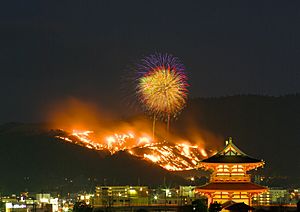
- Nara Marathon
- Nara Centennial Hall
- Nara Kasugano International Forum Iraka
- Shuni-e (a Buddhist ceremony)
- Gallery
The Famous Deer of Nara
Nara is famous for its wild sika deer. These deer roam freely, especially in Nara Park. A legend says that a god arrived in Nara on a white deer. Because of this, the deer are seen as special, heavenly animals that protect the city.
In 2015, there were over 1,200 sika deer in Nara. You can buy sika senbei (deer crackers) from vendors to feed them. Some deer have even learned to bow to get a cracker!
Deer Health and Diet
A study in 2009 looked at the health of deer in Nara Park. It found that many deer were not getting enough nutrients. This was because they ate too many rice crackers and other human food. Rice crackers don't have enough fiber or other things deer need. Eating too many can upset their stomachs.
The study showed that deer in Nara Park were smaller than deer outside the park. This was a sign of poor nutrition. Rice crackers made up about one-third of the deer's diet in the park. The rest was grass.
There isn't enough grass in Nara Park for all the deer. This makes them rely on humans for food. They might even eat trash or plants they normally wouldn't.
Overpopulation and Its Effects
The deer in Nara Park have become very numerous. This is because people feed them often, and there are few predators. This large number of deer has caused problems. They damage trees by eating the bark and bamboo by eating the shoots.
Also, the deer can become aggressive when they want food. This can sometimes lead to people getting hurt. They also fight with each other for crackers. Because they are so used to humans, they have lost their natural fear of predators.
Because of these issues, it's a good idea for visitors to observe the deer instead of feeding them.
- Gallery
Education in Nara
As of 2005[update], Nara city has 16 high schools and 6 universities.
Universities for Higher Learning
- Nara Women's University is one of only two national women's universities in Japan.
- Nara Institute of Science and Technology is a university for advanced research. It focuses on biology, information, and materials science.
Schools for Kids
- Public elementary and junior high schools are run by Nara city.
- Public high schools are run by Nara Prefecture.
- Private high schools include Todaiji Gakuen, which was started by a temple in 1926.
Getting Around Nara: Transportation
The main train station in Nara is Kintetsu Nara Station. The JR Nara station is about 500 meters to the west.
Train Lines
- West Japan Railway Company
- Kansai Main Line (Yamatoji Line): Narayama Station – Nara Station
- Sakurai Line (Manyō-Mahoroba Line): Nara Station – Kyōbate Station – Obitoke Station
- Kintetsu Railway
- Nara Line: Tomio Station – Gakuen-mae Station – Ayameike Station – Yamato-Saidaiji Station – Shin-Ōmiya Station – Kintetsu Nara Station
- Kyoto Line: Takanohara Station – Heijō Station – Yamato-Saidaiji Station
- Kashihara Line: Yamato-Saidaiji Station – Amagatsuji Station – Nishinokyō Station
- Keihanna Line: Gakken Nara-Tomigaoka Station
Major Roads
- Expressways
- Keinawa Expressway (Still being built)
- Hanshin Expressway Dainihanna Route
 Japan National Route 24
Japan National Route 24 Japan National Route 25
Japan National Route 25 Japan National Route 169
Japan National Route 169 Japan National Route 308
Japan National Route 308 Japan National Route 369
Japan National Route 369 Japan National Route 370
Japan National Route 370
Nara's Sister Cities
Nara has special friendships with cities around the world and in Japan. These are called "sister cities" or "twin towns."
International Sister Cities
 Canberra, Australia
Canberra, Australia Gyeongju, Gyeongsangbuk-do, South Korea
Gyeongju, Gyeongsangbuk-do, South Korea Toledo, Province of Toledo, Spain
Toledo, Province of Toledo, Spain Versailles, Yvelines, France
Versailles, Yvelines, France Xi'an, Shaanxi, China
Xi'an, Shaanxi, China Yangzhou, Jiangsu, China
Yangzhou, Jiangsu, China
Japanese Sister Cities
 Dazaifu, Fukuoka Prefecture, Japan
Dazaifu, Fukuoka Prefecture, Japan Kōriyama, Fukushima Prefecture, Japan
Kōriyama, Fukushima Prefecture, Japan Obama, Fukui Prefecture, Japan
Obama, Fukui Prefecture, Japan Tagajō, Miyagi Prefecture, Japan
Tagajō, Miyagi Prefecture, Japan Usa, Ōita Prefecture, Japan
Usa, Ōita Prefecture, Japan
See also
 In Spanish: Nara (Nara) para niños
In Spanish: Nara (Nara) para niños


